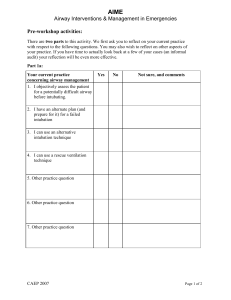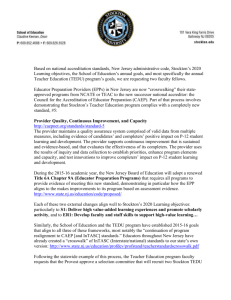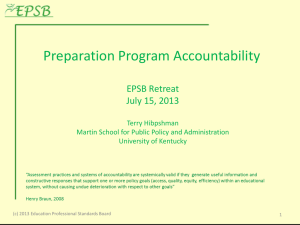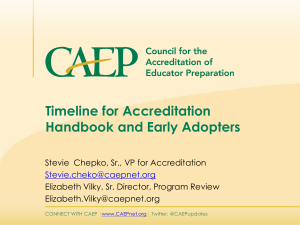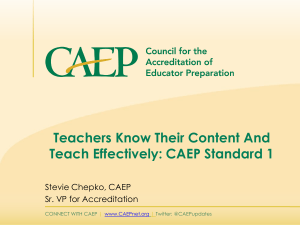Transitioning from NCATE and TEAC to CAEP
advertisement
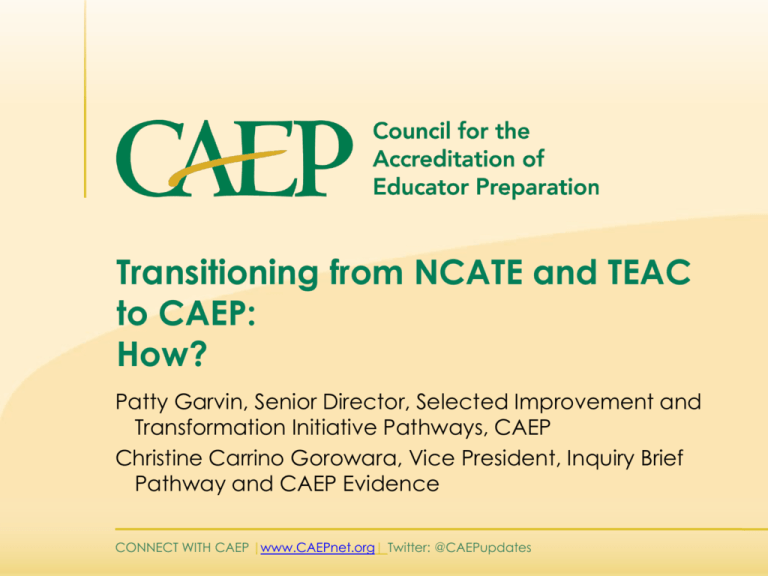
Transitioning from NCATE and TEAC to CAEP: How? Patty Garvin, Senior Director, Selected Improvement and Transformation Initiative Pathways, CAEP Christine Carrino Gorowara, Vice President, Inquiry Brief Pathway and CAEP Evidence CONNECT WITH CAEP |www.CAEPnet.org| Twitter: @CAEPupdates Building on Strong Foundations New Enhanced Common CONNECT WITH CAEP |www.CAEPnet.org| Twitter: @CAEPupdates CAEP Standard 1 The provider ensures that candidates develop a deep understanding of the critical concepts and principles of their discipline and, by completion, are able to use discipline-specific practices flexibly to advance the learning of all students toward attainment of collegeand career-readiness standards. CONNECT WITH CAEP |www.CAEPnet.org| Twitter: @CAEPupdates NCATE: NEW / ENHANCED 1.1 InTASC standards – Enhanced 1.2 Candidates use research and evidence –Enhanced 1.3 The National Board for Professional Teaching Standards (NBPTS) - Enhanced 1.4 College- and career-ready standards – New 1.5 Model and apply technology standards - Enhance CONNECT WITH CAEP |www.CAEPnet.org| Twitter: @CAEPupdates TEAC: New and enhanced • 1.1 Candidates demonstrate an understanding of the 10 InTASC standards at the appropriate progression level(s) in the following categories: the learner and learning; content; instructional practice; and professional responsibility. • 1.2 Providers ensure that completers use research and evidence to develop an understanding of the teaching profession and use both to measure their P-12 students’ progress and their own professional practice. CONNECT WITH CAEP |www.CAEPnet.org| Twitter: @CAEPupdates TEAC: New and enhanced • 1.3 Providers ensure that completers apply content and pedagogical knowledge as reflected in outcome assessments in response to standards of Specialized Professional Associations (SPA), the National Board for Professional Teaching Standards (NBPTS), states, or other accrediting bodies (e.g., National Association of Schools of Music – NASM). • 1.4 Providers ensure that completers demonstrate skills and access to rigorous college- and career-ready standards (e.g., Next commitment that afford all P-12 students Generation Science Standards, National Career Readiness Certificate, Common Core State Standards). • 1.5 Providers ensure that completers model and apply technology standards as they design, implement and assess learning experiences to engage students and improve learning; and CONNECT WITH CAEP |www.CAEPnet.org| Twitter: @CAEPupdates enrich professional practice. CAEP Standard 2 The provider ensures that effective partnerships and high-quality clinical practice are central to preparation so that candidates develop the knowledge, skills, and professional dispositions necessary to demonstrate positive impact on all P-12 students’ learning and development. CONNECT WITH CAEP |www.CAEPnet.org| Twitter: @CAEPupdates NCATE: NEW / ENHANCED 2.1 Partners co-construct mutually beneficial… mutually agreeable expectations …share accountability for candidate outcomes – Enhanced 2.2 Partners co-select, prepare, evaluate, support, and retain high-quality clinical educators, both provider- and school-based – Enhanced 2.3 The provider works with partners to design clinical experiences - New CONNECT WITH CAEP |www.CAEPnet.org| Twitter: @CAEPupdates TEAC: New and enhanced • 2.1 Partners co-construct mutually beneficial P-12 school and community arrangements, including technology-based collaborations, for clinical preparation and share responsibility for continuous improvement of candidate preparation. • 2.2 Partners co-select, prepare, evaluate, support, and retain high-quality clinical educators, both provider- and school-based, who demonstrate a positive impact on candidates’ development and P-12 student learning and development. • 2.3 The provider works with partners to design clinical experiences of sufficient depth, breadth, diversity, coherence, and duration to ensure that candidates demonstrate their developing effectiveness and positive impact on all students’ learning and development. CONNECT WITH CAEP |www.CAEPnet.org| Twitter: @CAEPupdates CAEP Standard 3 The provider demonstrates that the quality of candidates is a continuing and purposeful part of its responsibility from recruitment, at admission, through the progression of courses and clinical experiences, and to decisions that completers are prepared to teach effectively and are recommended for certification. The provider demonstrates that development of candidate quality is the goal of educator preparation in all phases of the program. This process is ultimately determined by a program’s meeting of Standard 4. CONNECT WITH CAEP |www.CAEPnet.org| Twitter: @CAEPupdates NCATE: New / Enhanced 3.1 The provider presents plans and goals to recruit and support completion of high-quality candidates – New 3.2 The provider ensures that the average grade point average of its accepted cohort of candidates meets or exceeds the CAEP minimum of 3.0 - New 3.3 Establish and monitor attributes and dispositions beyond academic ability – New CONNECT WITH CAEP |www.CAEPnet.org| Twitter: @CAEPupdates NCATE: New / Enhanced (con’t) 3.4 Ability to teach to college- and career-ready standards – New 3.5 Documents that the candidate…can teach effectively with positive impacts on P-12 student learning and development - New 3.6 Documents that the candidate understands the expectations of the profession, including codes of ethics, professional standards of practice, and relevant laws and policies - New CONNECT WITH CAEP |www.CAEPnet.org| Twitter: @CAEPupdates TEAC: New and enhanced • The provider sets admissions requirements, including CAEP minimum criteria or the state’s minimum criteria, whichever are higher, and gathers data to monitor applicants and the selected pool of candidates. CONNECT WITH CAEP |www.CAEPnet.org| Twitter: @CAEPupdates CAEP Standard 4 The provider demonstrates the impact of its completers on P-12 student learning and development, classroom instruction, and schools, and the satisfaction of its completers with the relevance and effectiveness of their preparation. CONNECT WITH CAEP |www.CAEPnet.org| Twitter: @CAEPupdates NCATE: New / Enhanced 4.1 The provider demonstrates the impact of its completers on P-12 student learning and development, classroom instruction, and schools, and the satisfaction of its completers with the relevance and effectiveness of their preparation. – New 4.2 Completers effectively apply the professional knowledge, skills, and dispositions that the preparation experiences were designed to achieve – New CONNECT WITH CAEP |www.CAEPnet.org| Twitter: @CAEPupdates NCATE: New / Enhanced (con’t) 4.3 Employers are satisfied with the completers’ preparation –Enhanced 4.4 Program completers perceive their preparation as relevant to the responsibilities they confront on the job, and that the preparation was effective - Enhanced CONNECT WITH CAEP |www.CAEPnet.org| Twitter: @CAEPupdates TEAC: New and enhanced • The provider demonstrates the impact of its completers on P-12 student learning and development, classroom instruction, and schools, and the satisfaction of its completers with the relevance and effectiveness of their preparation. CONNECT WITH CAEP |www.CAEPnet.org| Twitter: @CAEPupdates CAEP Standard 5 The provider maintains a quality assurance system comprised of valid data from multiple measures, including evidence of candidates’ and completers’ positive impact on P-12 student learning and development. The provider supports continuous improvement that is sustained and evidence-based, and that evaluates the effectiveness of its completers. The provider uses the results of inquiry and data collection to establish priorities, enhance program elements and capacity, and test innovations to improve completers’ impact on P-12 student learning and development CONNECT WITH CAEP |www.CAEPnet.org| Twitter: @CAEPupdates NCATE: New / Enhanced 5.2 The provider’s quality assurance system relies on relevant, verifiable, representative, cumulative and actionable measures, and produces empirical evidence that interpretations of data are valid and consistent. – Enhanced 5.3 Tests innovations and the effects of selection criteria on subsequent progress and completion – New 5.4 Measures of completer impact, including available outcome data on P-12 student growth – New CONNECT WITH CAEP |www.CAEPnet.org| Twitter: @CAEPupdates TEAC: New and enhanced • 5.4. Measures of completer impact, including available outcome data on P-12 student growth, are summarized, externally benchmarked, analyzed, shared widely, and acted upon in decisionmaking related to programs, resource allocation, and future direction. • 5.5. The provider assures that appropriate stakeholders, including alumni, employers, practitioners, school and community partners, and others defined by the provider, are involved in program evaluation, improvement, and identification of models of excellence. CONNECT WITH CAEP |www.CAEPnet.org| Twitter: @CAEPupdates CAEP PROCEDURES: New for NCATE Accredited EPPs • “Tagging” evidence in the Self-study • Formative Feedback through an offsite review and report • EPP representative(s) at initial review panel of the Selected Improvement and Transformation Initiative Commissions. CONNECT WITH CAEP |www.CAEPnet.org| Twitter: @CAEPupdates CAEP PROCEDURES: New for TEAC Accredited EPPs • Program review (3 options) CAEP Program Review with National Recognition CAEP Program Review with Feedback State Program Review • Offsite review by the visitor team CONNECT WITH CAEP |www.CAEPnet.org| Twitter: @CAEPupdates
